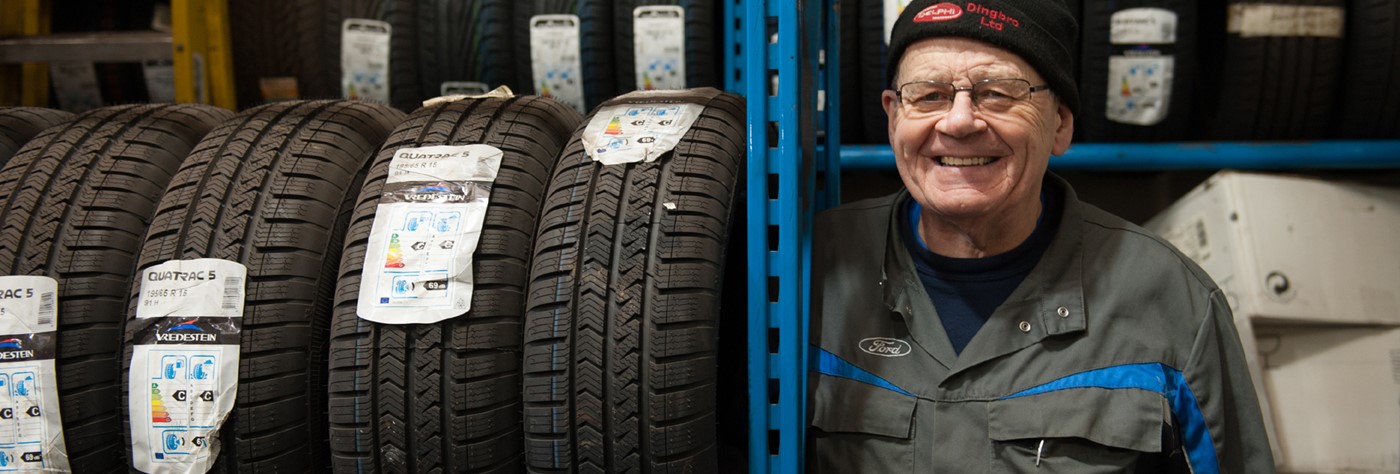
Tyres
Woodlands Service Centre has an extensively stocked tyre departments plus a tyre workshop installed with dedicated, high specification tyre changers and the very latest 4-wheel alignment system via a dedicated ramp. Our technicians have the equipment and expertise to be able to advise you on everything there is to know about tyres and wheel balancing.
Tyres are the vehicle's only point of contact with the road and the actual area of contact is small so bald tyres (slicks) may be fine for a racing car on a dry track, but they are totally unsuitable for road vehicles on a wet road surface. Tyres treads are designed to pump water from the road surface so providing maximum grip. By the time the tread is worn down to the legal limit - there must be at least 1.6mm of tread depth across the centre 3/4 of the width of the tread throughout the entire circumference of the tyre; no damage to the tyre body, sidewalls or tread; no bulges or cuts - they are unable to perform this task efficiently and MUST be replaced. We advise that worn tyres are replaced with new when the tread depth falls below 3mm and we strongly advise against the use of part worn or retreaded tyres.
TYRE PROBLEMS
Uneven tyre wear? Steering wheel off-centre or pulling to none side? Let us carry out a full 4-wheel alignment check using our state of the art camera operated alignment equipment which guarantees accuracy as per the tyre manufacturer's requirement. Prices start from £30.
TYRE TYPES
Car vehicle manufacturers choose the type, make, size, profile, load carrying capacities and speed ratings to match their vehicles, adjusting the tyre pressures to give the optimum grip, ride and handling characteristics. It is illegal to mix tyres of a different construction (cross-ply; bias belted or radial) on the same axle. Cross-ply and bias-belted tyres are seldom used on production cars and are not widely available in the UK. Cross-ply and radial tyres should never be mixed on the same vehicle and if a mix is necessary, radial tyres MUST only ever be used on the rear axle and cross-ply tyres on the front. This mix of tyres will produce 'understeer' ( vehicle turns at less of an angle than it is steered) whereas the opposite will produce 'oversteer' (vehicle turns more tightly into a corner than it is steered). Understeer is generally accepted to be easier to control.
UNDERSTANDING TYRE SIZES
- Three-digit number on the side of the tyre ie 205 = type width in millimetres
- Two-digit number ie 55 = height of the tyre's sidewall as a percentage of the width and known as the aspect ratio
- R = radial tyre of which all tyres are now
- Two-digit number ie 17 = diameter of the tyre in inches
TYRE CARE
Guidance on how to look after your tyres can be found in your car handbook, together with information about vehicle loading and tyre pressure adjuments which should be followed for safety. Tyre pressures should always be checked and corrected (if necessary) when they are cold and it is vital that the correct pressures are maintained to ensure maximum tyre life, safety, the best ride and handling characteristics. Over or under-inflating tyres are likely to seriously impair their performance.
Service and Repair Code

The Service and Repair Code commits garages to an open, transparent and fair method of business, aiming to maintain consistently high standards across the industry. By subscribing to the Code, a garage is demonstrating its commitment to operate as a responsible business and deliver high levels of customer satisfaction.
In November 2011, the Service and Repair Code was awarded full Office of Fair Trading approval and now operates as a Trading Standards Institute approved code, giving you the confidence that, with a garage accredited to The Motor Ombudsman, you can be sure to receive a professional, reliable service.
